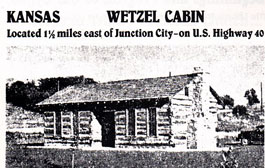 |
This cabin was moved and restored by the Kansas District Lutheran Laymen's League, dedicated as a memorial June 5, 1955, and is now maintained by the Kansas Lutheran Historical Society, Inc. It stands at the junction of K57 and I-70. |
History of Trinity Lutheran Church
[Events through 50th anniversary are taken from Silver Jubilee booklet dated 6-14-59 when H. William Lieske was pastor of Trinity Lutheran Church (LCMS) in Salina, Kansas, and from subsequent anniversary celebration booklets.]
The Prelude Years
The land which is now the State of Kansas was a part of the Louisiana Purchase acquired by the United States Government in 1803. Prior to that it is reported that Coronado traversed part of the "state," coming close to Salina, in 1541. Lewis and Clark touched a part of the northeast corner during their exploration journeys of 1804-1805. The "state" was largely Indian and buffalo country and for many years was a place to "pass through." The Santa Fe Trail, beginning in 1822, and the Oregon and California trails of the 1840's carried many people through Kansas to other parts. However, in the 1840's and 50's more people began to settle and on March 30, 1854, the Territory of Kansas was established and on January 29, 1861, Kansas became the 34th State of the Union. Butterfield's Denver Stage of 1866 passed through Salina and the Kansas Pacific Railroad reached this part of the state in 1867 and greatly spurred Salina's growth.
It was 1861 that the first organized work of our church in Kansas was started by Missionary F.W. Lange who was sent to Kansas and held his first service on August 17, 1861, in the C.F. Wetzel cabin on Clark's Creek about 7 miles southeast of Junction City. From that humble beginning the work spread to many parts of the state, but it was a long time before our church established work in the city of Salina.
 |
This cabin was moved and restored by the Kansas District Lutheran Laymen's League, dedicated as a memorial June 5, 1955, and is now maintained by the Kansas Lutheran Historical Society, Inc. It stands at the junction of K57 and I-70. |
If our information is correct, the first settlers of Saline County were Gotthart and John Schippel, who came in the summer of 1856 and settled on the Saline River about three miles northeast of the present Salina (in 1959). About that same time an attempt was made to establish a town called "Mariposa" at the mouth of the Saline River. In the summer of 1857 an attempt was made to establish the town of "Buchanan" near the mouth of the Solomon River. Both of these attempts failed, but the County of Saline was officially established on April 27, 1860, with Charles Holtzman, Israel Markley, and A. C. Spilman serving as Commissioners. In March 1858 the town of Salina was founded by W. A. Phillips, A. M. Campbell, James Muir, Robert Crawford, and A. C. Spilman. On March 30, 1859, the Town Company was granted a charter by the Sixth Territorial Legislature of Kansas. Thus, the state in the heart of the nation, and the county and city at the heart of the state, came into being.
Organized Church Work in Salina
The first churches were organized in Salina in 1860. First Presbyterian was organized May 12, 1860, and Sacred Heart Cathedral was also organized that same year. The first Lutheran Church in Salina was the Immanuel Lutheran (Augustana) which was organized May 11, 1870, and was followed some after by St. John's Lutheran (ULCA) which was organized March 30, 1873. It was more than 60 years after this that our Trinity Lutheran church was organized in October 1934.
Messiah Evangelical Lutheran Mission
Just when were the first attempts made to establish a congregation of Lutheran Church--Missouri Synod (LCMS) in the city of Salina? As is often the case, the very first beginnings cannot be established with definite accuracy, but some interesting facts are known.
Possibly the very first contacts were made in the year 1923 or 1924 when the Rev. F. W. Grunwald held services in Salina. Pastor Grunwald served at Immanuel Ellsworth from 1919 to 1925. The congregation there was organized in 1916. In a letter he wrote that he held services in a certain home and also baptized a child for the people but did not recall the name. Mr. & Mrs. Ed Berhorst of Sylvan Grove were sponsors for the child. It is also reported that he conducted a few services in the Kansas Wesleyan Commercial Building.
The first organized attempt to establish church work in Salina took place in the fall of 1924. On leaving the Post Graduate Department of Concordia Theological Seminary in St. Louis MO, Arthur E. Neitzel was called by the Mission Board of the Kansas District to do exploratory work in Salina and vicinity. He arrived with his wife on the first day of September 1924. After spending a month in the hotel, Pastor and Mrs. Neitzel lived at 1028 W. Ash (the first "parsonage"). Pastor Neitzel was ordained and installed by the Rev. F. A. Mehl of Sylvan Grove during the course of a Mission Festival Service at Immanuel Lutheran Church in Ellsworth on September 27, 1924. The mission effort here was promoted by Rev. Mehl who was deeply interested in Salina.
This initial work was carried on under most difficult and trying circumstances. Rev. Neitzel stated in a letter: "Twenty names I had of former Lutherans proved to be on a list too old for any good. These people could not be found. I canvassed and found a few people to attend worship." No money was made available for rental of a place of worship so the basement room of the library was used for a start.
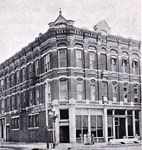 |
Then a class room in the third story of the Kansas Wesleyan Commercial College was used. This building stood at the corner of Walnut and Santa Fe and was later occupied by several other establishments. Pastor Neitzel found it necessary to carry children up flights of stairs for mothers who protested that they couldn't come to worship there because of the inconvenience. |
This mission was called "Messiah Evangelical Lutheran Mission" and is a direct forerunner of our Trinity Lutheran congregation of today. For this we have documentary evidence on a reproduced promotional card, and by notices in the Salina Evening Journal of that day which were found by Pastor Lieske.
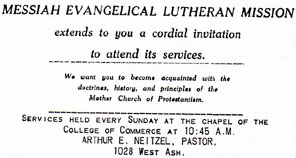 |
In the micro-filmed archives of the Journal, the first notice of services was found in the October 18, 1924, issue of the paper and other notices appeared after that. Canvass cards and other advertising materials were mimeographed at St. John's College in Winfield, KS. Pastor Neitzel also surveyed Abilene and preached there once or twice. After six months of work, there seemed to be reasonable prospects but a sudden need at My Calvary Mission in Marysville, KS, caused the Mission Board to send Pastor Neitzel there (the Marysville congregation was organized in 1928). Pastor and Mrs. Neitzel left Salina on February 14, 1925, and thus ended the brief history of Messiah Evangelical Lutheran Mission of Salina.
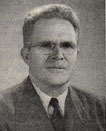 |
The Founding Years helping the Salina mission 1931-1933 Pastor Wm. J. Stelling |
The Rev. William J. Stelling came to Immanuel Lutheran Church of Ellsworth in 1929 and served there until 1948. From time to time he was in touch with people in Salina and, on a Sunday evening in January 1931, began holding worship services in the northwest part of the city. Salina at that time was a city of about 20,000 people. Services were held in a simple little hall, which at the time was owned by the United Brethren in Christ Church. It was located at what is now 121 N. Chicago just off of State Street. Services were continued by Pastor Stelling, with some interruptions, until August when the first resident pastor was called. Christine Eilrich of the Ellsworth congregation served as pianist during those months. Those were not days of super highways and high-speed travel. Pastor Stelling states: "At that time Highway 40 was being paved and I had to go on detours most of the way which were really terrific--either dust six inches deep or mud about the same depth--but I never got stuck or had an accident."
Shortly after services were started, the building was thoroughly cleaned by several members of the little Mission group. No sooner had this happened than the building was sold and the group was without a place to worship for several Sundays. On February 28, 1931, the United Brethren in Christ Church sold the building to the Jayhawk Building Association. Soon, however, they were permitted to use the building again, but it was shared with another organization.
 |
The "Hall" originally at 121 N. Chicago as it looks today at 117 N. Clark |
The Ku Klux Klan used the building for a time, and some people were actually kept from coming to church because of various rumors about the group. How long they used the building is not known but evidence of their presence was found from time to time. One Sunday a very crude cross about 8 feet high and made of two pieces of elm was found in the building. It is also reported that pictures were turned to the wall and various Klan paraphernalia was put aside when the little Mission group held worship services. No difficulties ever developed however. In fact they seemed to be quite cooperative, permitting the Mission to use some of their equipment, etc. Adding to, or subtracting from, the "atmosphere" at times was the old coal heater which often sent out choking fumes and smoke. The building was used for over two years, from January 1931 to the end of February 1933, when the little flock moved into its first regular House of Worship. The "Old Church" was then purchased by the Wesleyan Methodist Church (about 1939), moved to 117 N. Clark, and converted into a dwelling and, at one time, served as a parsonage for that church body.
|
|
The Rev. Walter G. Schmidt First Permanent Resident Pastor Years at Trinity 1931-1948 |
Walter G. Schmidt, a June graduate of Concordia Seminary in St. Louis, was called to the Salina Mission Station in 1931 by the Mission Board of the Kansas District. He was ordained by his father, the Rev. H. Schmidt, at Immanuel Lutheran Church of Canton on August 23, 1931. On Sunday evening a week later, August 30, he was installed at Salina by the Rev. Wm. Stelling, with his father and Rev. Henry Kroening (Circuit Visitor) of Lincoln assisting. For the first few years the young pastor lived and boarded at 141 N. 11th with a Mrs. Clevenger. United in marriage with Emma Russmann of Holyrood on September 16, 1934, their first "parsonage" was at 925 Highland. In July or August of the next year they moved to 675 S. 9th and still later to 663 S. 9th. In 1940 Pastor and Mrs. Schmidt moved into the parsonage at 409 W. Crawford.
Among those who first attended services at the hall on Chicago Street were the George P. Nissens, Ralph S. Kendles, John Masons, Gus Langers and Mrs. Mehmel, Martha Eilrich, Amanda Krueckenberg, Ella Bohl, Walter and Bert Schultz, Emma Schwerdtfeger, Edna Herrs, Marie and Victoria Brack, Viola and Mathilda Popp. Also attending services a little later were B. F. Propps, Leona Wohler, Ruth Benien, Pauline Fischer, Nora Petermann, Mrs. G. B. and Gladys Hopfer, and Rodena Schultz and her mother. The first Christmas Eve children's service was held December 24, 1931, and a copy of this service is preserved in the congregation's historical files. Early Sunday School teachers and helpers were Mrs. George Nissen and daughter Eulalah, Mrs. Ralph Kendle, Pauline Fischer, and Leona Wohler. Teachers' meetings were held at the Nissen home, 1200 S. 9th.
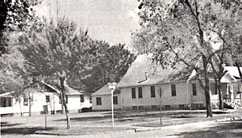 |
The first church is built at corner of West Crawford & S. 11th Street. (It becomes Parish Hall when the second church is built) Parsonage (left)--409 W. Crawford |
Since it was evident that no effective permanent work could be accomplished in rented and inadequate quarters, in the summer of 1932, the Mission Board of the Kansas District purchased two lots (100'x100') on the corner of West Crawford and South 11th Street for $1200. Through the years $800 in improvement taxes were also paid. Mr. George Schaefer, a Lutheran from Atchison, was engaged as contractor and the men of the church frequently pitched in with volunteer labor to help build this first church. The attractive white frame chapel, with basement, was built with funds provided by the church Extension Fund at a cost of $3500. The building was dedicated April 23, 1933, with the Rev. Wm. Stelling of Ellsworth delivering the morning sermon. Prof. E. A. Wolfram of St. John's College, Winfield, spoke in the afternoon and was in charge of the evening service. An estimated 900 people attended the three services in spite of threatening weather. The offerings amounted to $82.40. Special music was provided by a choir from Natoma and by an octet of children's voices under the direction of Prof. Hedemann of Sylvan Grove. An article in the Salina Journal of April 26, 1953, reporting on the "Good Old Days" of April 26, 1933, had this to say: "The Salina German Lutheran Church, or as it is officially known Salina's Lutheran Mission, Missouri Synod, was dedicated Sunday. The new church building at 11th & Crawford was filled for the three services Sunday."
The Salina Mission was organized as a regular congregation and took the name "Trinity" on October 31, 1934. At that time it numbered 31 communicants and 68 baptized souls. There was some uncertainty surrounding the early organization because the first constitution and some of the early minutes were carried off by the first secretary who moved away and forgot to leave these important documents behind. The first available minutes are those of July 10, 1935, which quote: "The minutes of the previous meeting were not read; the minute book having been lost." Thus, the important minutes of the organization meeting and perhaps two or three other meetings are not on record. The minutes of October 8, 1935, state that "Due to the loss of the constitution a new one was written...." The first officers of the congregation were: Elders: Ben F. Propp, Ralph S. Kendle, and Martin C. Hecht; Treasurer: Gustav Langer; Secretary: E. F. Kreutz, who was soon succeeded by Everett F. Hawkins. The same officers continued through 1936. Mr. Langer served as Treasurer for 10 years. In 1945 he was followed in office by Ted Kaempfe who served for 6 years. E. F. Hawkins served as secretary for over 10 years until he transferred to Topeka in 1948.
In May 1940 the property at 409 W. Crawford was purchased for $3600 for a parsonage. In the fall of 1940 Pastor Schmidt, with the support of several laymen, inaugurated "The Family Altar," a 15-minute program with music and message which was broadcast over KSAL one evening a week. Later, the congregation, as well as many listeners in the area, supported the program and it was well received for quite a number of years.
Other Special Dates--per excerpts from Minutes
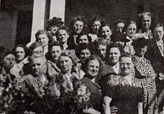 |
The Ladies Aid Society, later called The Women's Missionary Guild, was formed in February 1936. This picture taken on their 10th anniversary has their first 5 presidents in front row. On April 22,1954, the group affiliated with the Lutheran Women's Missionary League (LWML). |
A young people's society was organized in 1937 and it later became affiliated with the International Walther League in 1944 until that organization was disbanded. In 1943, beginning on Easter, April 25, Trinity started holding two morning services. On July 12, 1943, the congregation voted to join Synod and was accepted at the District Convention in Winfield that fall. The Lutheran Laymen's League was organized early in 1945 and its charter is dated February 27, 1945.
By Land and Air
The attack on Pearl Harbor, December 7, 1941, resulted in repercussions which affected many nations politically, economically, and in many other ways. Eventually, the situation lead to a growing Salina and thus also contributed to the growth of Trinity congregation. Smoky Hill Army Air Field (SHAAF), 3 miles south of Salina, was activated April 1942. The first enlisted men reported for duty July 17, 1942, and by December the field was busily training B-17 Flying Fortress Crews. In 1943 the 20th Bomber Command was formed and the Salina base became the first in the nation to train B-29 Super Fortress crews. At the same time the large troop cantonment and Camp Phillips beyond the Airfield was constructed. At one time 70,000 troops were in training there. All this activity brought a new economic surge to the area and attracted many people which, in turn, brought new growth to the church as people from Ellsworth, Lincoln, Sylvan Grove, and other surrounding towns moved into Salina. The airfield was closed in the fall of 1949; however with the outbreak of fighting in Korea, it was reactivated as a Strategic Air Command (SAC) B-29 Base, known as Smoky Hill Air Force Base (SHAFB). In July 1953 it was made a permanent installation, converted to B-47 jets in June 1954, and in March 1957 was renamed Schilling Air Force Base (SAFB).
Lutheran Service Center and Chaplaincy
With the influx of many servicemen, a need was felt for supplying a "home away from home." A note in the Sunday bulletin of January 24, 1943, stated that the pastor had on file 230 names of servicemen of our Synod. The three local Lutheran churches combined their efforts and established a Lutheran Service Center at 105½ N. 7th. This was in operation about two years during the period of heaviest concentration of servicemen in the area. It closed on October 31, 1944. Each of the three churches was in charge of the center for a full week. It began with a dinner on Sunday evening which was attended by 75-100 servicemen during the peak operation. The center was open every afternoon and evening from 3-11 pm and the church in charge saw to it that cookies, cake, recreation, etc., were provided. Two hostesses were also on hand during the open hours. Other churches in the area were helpful in supporting the center and also in taking charge from time to time. After the center was closed dinners were served at the church at noon on the 1st, 3rd, and 5th Sundays each month. Later this was changed to only the 1st Sunday each month. From time to time Missouri Synod Lutheran chaplains were stationed with units at the military installations. Some of these were quite closely associated with Trinity, preached for services, and also participated in other activities. Among these chaplains were: R. Klann, F. A. Graef, C. A. Heckman, H. Belsheim, and M. E. Ramming.
 |
Called by Synod's National Emergency Planning Council to be a "Wartime Missions and Conservation" worker. The Rev. Vernon Henning was installed at Trinity Church the night of March 7, 1943. |
Although he was very closely associated with Trinity and the Service Center, it was not in an official capacity. In a letter, he wrote: "As far as the Service Center was concerned, my activities were also unofficial. I was never assigned to the Center as such, but by tacit agreement among the three Lutheran churches, I spent every evening there as "spiritual advisor.'" He conducted services frequently at Trinity, particularly in the evening , and also at churches in the surrounding area. On March 20, 1944, he entered the military chaplaincy and terminated his services in the Salina area.
The Building Years 1945-1955
In the January 9, 1944, voters meeting, also the Tenth Anniversary Year, it was voted to become self-supporting. This meant no more subsidy support would be received from the District. In the previous year, subsidy in the amount of $750 had been received and amounts up to $960 per year had been received up to that time. In this same meeting, the Trustees were instructed to get information on a new building site. In October the Church Extension Board was sent a check for $2766.46 which paid off the entire debt against the church property. In 1945, two lots south of Crawford on the east side of 10th Street, plus a third lot, were purchased for a total of $2617.70, including attorney fees, and a Building Finance Committee appointed, as well as an Organ Committee. In July of 1948 it was reported that sufficient funds were on hand and in sight to proceed with the building project. Pastor Schmidt accepted a call and preached his farewell at Trinity on August 29, 1948. The Rev. O. A. Bohnert of Grace Lutheran Church, McPherson, served as vacancy pastor. The service for laying the cornerstone of the new building was at 3:00 pm on Sunday, October 31, 1948. The Rev. O. Henning of Holyrood, Mission Director, was the guest speaker. Attendance at the service was 304 and the special offerings amounted to $633.17.
 |
The Second Pastor at Trinity The Rev. Victor G. Meyer Years at Trinity 1949-1955 |
The Rev. Victor G. Meyer of Immanuel Lutheran Church at Lawrence, Kansas, accepted Trinity's call and was installed on December 5, 1948. Beginning in 1949 regular choir rehearsals were held on Wednesday evenings. On April 3 the purchase of a pipe organ for the new church was authorized.
New church is dedicated
|
Dedication Day was June 12, 1949. Size 100'x30', interior--haydite block and exterior-- Wisconsin Lannon Stone trimmed with Kansas Silverdale Limestone; windows--art glass with Christian symbols; roof--red asbestos shingles; seating capacity 400. Cost $84,968.04, of which $4257.50 was for organ, plus $3733.98 more for landscaping, pews & misc.= $88,770. |
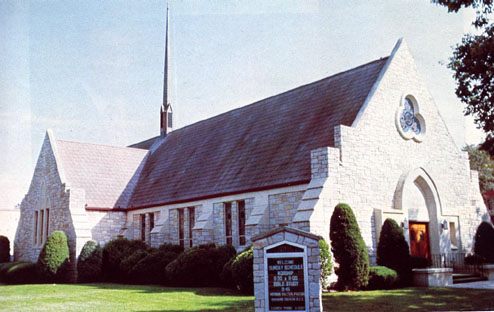 |
The new church and facilities added much to the worship and program of the church. Soon the need for additional education space was a topic for study and discussion. Improvements were made at the old church which became the Parish Hall with the construction of the new church. A rear stairway and grade level door was installed for a safety measure and to improve the flow of traffic.
Pastor Meyer accepted a call and his farewell service was held October 30, 1955. The Rev. William Britton at Grace Lutheran in McPherson was chosen to serve as vacancy pastor.
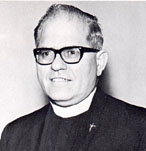 |
The Third Pastor at Trinity The Rev. H. William Lieske Years at Trinity 1956 to 1960 |
Pastor Lieske was installed January 1, 1956. Volume 1, Number 1, of The Trinity Lutheran appeared January 20, 1956, bringing information reports, articles, etc., to members and friends. A complete record system for individual members, communicants and baptized souls was set up. Temporary provision for additional education space took the form of four classrooms added to the east end of the Parish Hall, completed in June of 1956 for about $1400. All the work was done by members of the congregation. Miss Marilyn Faulk became office secretary in July, along with Mrs. Elvera (Harold) Miller in October, both on a part-time basis. Mrs. Pauline (Frank) Polach had previous done considerable part-time work at home. The newly revised and enlarged Constitution and Bylaws became effective January 1, 1958.
Acquisition of Educational Building (Trinity Hall)
The congregation became debt free on November 16, 1958, and on December 12 voted to accept the Building Committee's proposal to negotiate for the purchase of the M. J. Watkins property (six lots, store building, and parking lot) just east of the corner of 9th and Crawford not to exceed $155,000. (The building was formerly occupied by the Mammel Grocery Store.) Negotiations were completed May 16, 1959, to purchase said property for $135,000 and to remodel it to provide 18 classrooms, 2 offices, auditorium, kitchen, and a storage area. The debt on this project was retired in 1973.
The trim rock on the church was cleaned and sealed with silicon against further discoloration by dirt and grime. As of the 25th Anniversary (Silver Jubilee) on June 14, 1959, the membership at Trinity numbered 510 communicants and 840 baptized souls. Pastor Lieske accepted a call just over four years after he arrived. The Rev. J. Einar Bach of Herington served as vacancy pastor until the Rev. Martin Mappes was installed as Trinity's 4th pastor.
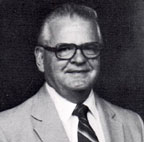 |
The Fourth Pastor at Trinity The Rev. Martin L. Mappes Years at Trinity 1960-1972 |
During these years, the congregation applied for its first vicar. All in all Trinity had a total of six vicars, as follows:
|
|
|
|
|
|
|
Alvin Schmidt 1961-1962 |
Clark Wilkie 1962-1963 |
John Hargreaves 1963-1964 |
Paul Graff 1964-1965 |
Walter Brill 1965-1966 |
John Werner was our sixth vicar. He would have served 1966-1967 but, after a stay of only three months, he entered the Army. Iten decided to call a DCE (Director of Christian Education) instead of a vicar. During the vicarage years Trinity Hall was dedicated in 1962. The Rev. Stanley Jones accepted a call to establish a congregation in south Salina in 1962. Christ the King Lutheran Church was organized and held their first services on January 6, 1963. Transfers from Trinity consisted of 138 baptized souls. A fund was started to air condition Trinity church. Pastor Mappes was married July 26, 1964, to Doris Awe, a Deaconess from Enid, OK. The newly built sanctuary of Christ the King was dedicated in January 1965. In September 1966 a youth choir for grades 3-8 was started under the leadership of Mrs. Marian Kandt. In 1968 Trinity sold the former church building (later used as Parish Hall) at 11th and Crawford Streets to the Reorganized Church of Latter Day Saints. Also in 1968 Trinity had its first pictorial booklet of its members published to help members get to know each other better.
 |
Trinity's first DCE Harlan F. Teske Years at Trinity 1968-1972 |
In February 1968 Harlan Teske was installed as Trinity's first DCE. A new parsonage was purchased at 1208 Sunrise Drive and the old parsonage sold. A tape-chimes system was installed in our church in October 1968. In 1969 Rev. Jack Crippen accepted a call to Christ the King. The Kansas District's Ambassadors for Christ, working through Christ the King, began Discovery Patrol. Christ the King asked Trinity to assist and a Saturday School was begun in north Salina. Mr. and Mrs. Ed Person willed their home and property at 134 E. Minneapolis to the congregation and it was used as a home for the DCE. In 1970 Pastor Darold Deterding was installed at Christ the King. The name of "Brothers and Sisters" was adopted for the youth choirs. In February 1971, the Concerned Christians opened Ambassador Hall at 1214 N. Santa Fe in a renovated 4 apartment building. Norman Dierking, the summer vicar at Ambassaddor Hall (the north end project), carried out a house-to-house canvass in the area, as well as a Vacation Bible School program for the students enlisted through the canvass.
|
Dedicated in June 1962 Trinity Hall at the corner of 9th and Crawford, our new Education Building, had glass windows in front. In 1971 they were enclosed to protect the children from the possibility of glass breakage. |
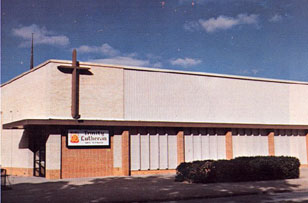 |
A Dual Vacancy in 1972
Saturday evening services began in April of 1972 and then discontinued when Pastor Mappes left. At a special voter's meeting on June 21 both Pastor Mappes and Mr. Teske were given peaceful releases to accept individual calls. Pastor Mappes preached his farewell sermon on July 9 and Mr. Teske left in mid-August. Pastor Darold Deterding served as vacancy pastor until the arrival of Pastor Norman E. Walter.
 |
The Fifth Pastor at Trinity Installed October 1, 1972 The Rev. Norman E. Walter Years at Trinity 1972-1979 |
The Christmas Children's Service was held at Central High School where all could gather and worship together. There were 901 at this service. In January the Brothers and Sisters group sang on the national Lutheran Hour program. In 1973 a mortgage burning service was held to celebrate the debt-free condition of the church in paying off the final installments for Trinity Hall. The church sanctuary was remodeled in 1975 before the Double Anniversary Celebration on October 28. It was during Pastor Walter's ministry that the congregation changed from providing a parsonage for the pastor to providing a housing allowance so they could select their own housing and hopefully be able to build up some equity in their home prior to relocating. Pastor Walter's farewell was held in Trinity Hall on December 1979.
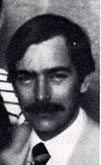 |
The 2nd DCE at Trinity Gary L. Bertels Installed April 8, 1973 Years at Trinity 1973-1975 |
Following service at Trinity, Mr. Bertels entered Concordia Seminary, St. Louis. He was ordained into the pastoral ministry in 1976.
|
The 3rd DCE at Trinity Rich Soeken Years at Trinity 1976 to 1979 |
|
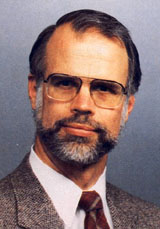 |
The Sixth Pastor at Trinity Installed July 27, 1980 The Rev. Daniel M. Schmalz Years at Trinity 1980-1989 |
An official call was issued for another DCE after Pastor Schmalz was installed.
|
The Fourth DCE at Trinity Installed January 24, 1982 Marvin Moss Years at Trinity 1982 to 1984
|
|
Renovation of Trinity Hall
In 1982 Trinity approved a $125,000 renovation plan for Trinity which added additional classrooms (by use of movable partitions for the auditorium), a nursery, and two offices, plus remodeling all the existing rooms. The debt on this project was retired in 1988. Other major improvements at various times included new air conditioning, organ repairs, church carpeting, kitchen additions, nursery with toilet facilities, sacristry, upstairs youth room, etc.
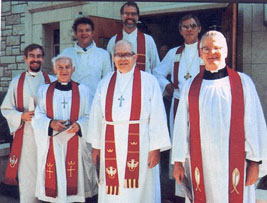 |
"Lengthen our cords and strengthen our stakes" Is. 54:2 50th Anniversary of Trinity Lutheran Church 1934-1984 Present at celebration (clockwise from center top): Pastors Schmalz, Walter, Mappes, Lieske, Schmidt, Bertels, and DCE Soeken, |
Marvin Moss resigned his position at Trinity as of July 31, 1984. The decision of the congregation at that time was to call an associate pastor instead of another DCE. Our first associate pastor was the Rev. Wendell L. Haubein. In 1989 Pastor Dan accepted a call to Sayville, NY, and preached his farewell sermon on August 27. An official call was then extended to Pastor Haubein to become the Senior Pastor at Trinity and he accepted.
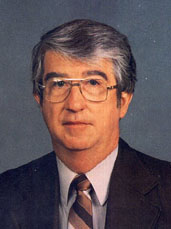 |
Installed as lst Associate Pastor April 21, 1985 Installed as 7th Senior Pastor January 21, 1990 The Rev. Wendell L. Haubein Years at Trinity 1985-1996 |
Christ the King dedicated its new sanctuary June 3, 1990. On June 24, 1990, the Rev. Michael W. Barnes was installed as an Associate Pastor at Trinity.
Addition of New Parking Lot
In 1990 Trinity purchased property south of church (the house was sold and moved off) and paved the lot to add a total of 21 parking spaces, for an approximate investment of $70,000, which was paid off in January 1993.
|
The Second Associate Pastor at Trinity Installed June 24, 1990 The Rev. Michael W. Barnes Years at Trinity 1990-1994 |
 |
On February 28, 1993, Trinity members voted to approve a major renovation and expansion program that would make the two existing facilities become one by connecting them with an expanded narthex that would also serve as our main entrance, subject to at least 50% of the $750,000 estimated cost being funded in cash or pledges prior to considering construction (Architect--Ken Biberly). As of May 4, 1993, Trinity had 907 communicants and 1196 baptized souls. A special Expansion Fund Drive Committee was appointed to organize the contacting of every member, with a goal to secure gifts and pledges to enable us to possibly be able to start this expansion project within three years. In the November 1993 voters' meeting the congregation approved bylaw changes to add a new Board of Health and Family Life, making a total of eight administrative boards at Trinity.
After four years of service at Trinity, Pastor Barnes accepted a call to be Pastor at King of Glory Lutheran Church in Cheyenne, WY. His farewell sermon was given on August 14, 1994. On October 23, 1994, the congregation voted to call both a new Associate Pastor and a DCE. Since Pastor Haubein had announced his plans to retire as of October 1, 1996, it was voted to issue a call for a Senior Pastor-Elect who would come to the parish as soon as possible after accepting the call with the understanding that he would automatically become the Senior Pastor as of that date.
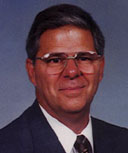 |
Installed as Senior Pastor-Elect February 11, 1996 Became the 8th Senior Pastor on October 1, 1996 The Rev. Robert C. Schaedel Years at Trinity 1996-Present |
On June 2, 1996, it was voted to embark on an additional three-year fund raising project for the church expansion project with a special emphasis on reaching the goal of $375,000 the first year or sooner so that construction could start, and that the congregation authorize the architect to complete the construction plans. At that time, the architect's estimate was that the project itself would cost $634,000, with his fees as architect estimated at $42,243.
On October 6, 1996, a service of Praise and Thanksgiving for the Ministry of Wendell L. Haubein was held at Trinity to commemorate his retirement as Senior Pastor at Trinity. On February 23, 1997, the congregation issued a call for another Associate Pastor.
|
The Third Associate Pastor at Trinity Installed June 1, 1997 The Rev. Charles W. Adams Years at Trinity 1997-Present |
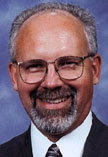 |
The May 29, 1997, report of the Youth Ministry Board showed that over 200 tapes of Ivis Meitler playing her piano music had been sold thus far, raising over $1,000 for the Building Fund. The notice for the July 20, 1997, special voter's meeting to review contractors' bids for the Building Expansion Project stated that contributions to date to this fund totaled $392,725.25. It was voted 133 to 2 to hire Rapp Construction Company as general contractor ($617,600 bid) for the project and to apply for and borrow $350,000 from LCEF (Lutheran Church Extension Fund) to finance that part of the project for which we did not have the funds in our savings account at LCEF. A new roof was also added to the church at an approximate cost $14,000.
After placing many unsuccessful calls for a DCE (first call issued May 7, 1995), a call was placed to Dana Oleson on June 8, 1997, and this call was accepted.
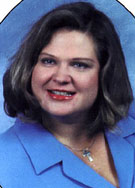 |
Installed as Director of Education and Youth August 17, 1997 Dana Oleson (married Rick Beck 11-11-98) Years at Trinity 1997-July 14, 2001 |
Dana married Rick Beck on November 11, 1998. She resigned her position to move to Houston TX with her husband when he accepted a job transfer there.
Building Renovation Project
Ground-breaking ceremony was September 21, 1997. Work on the building started and progressed rapidly. The outside structures to close in the alleyway between the existing buildings and for the approved addition was completed first so that the inside work could proceed during inclement weather. By June 1998 the contractor had finished all the outside work, the new fellowship hall and other additional space which contained new offices and work area for staff, plus an extra room for the library. After worship services on June 15, 1998, all the church pews were moved to Trinity Hall so they could start renovating the sanctuary. For 3½ months church services were conducted in Trinity Hall. The sanctuary renovation work was finished and the pews moved back after worship services on October 4. During the renovation time, the adult bible class and any other planned group activity during that period used the space available in the new fellowship area.
|
|
|
|
Pews set up in Trinity Hall |
Pews put back in renovated sanctuary |
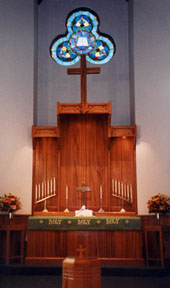 |
Following renovation which moved the altar area to the opposite end of the sanctuary, the Trinity window on the west side of the church building is now centered above the altar. Previously (as shown to the right) the three windows to the east side were above the altar. |
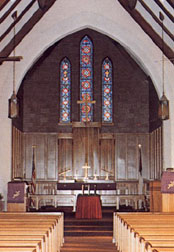 |
These three stained glass windows now are above the new choir loft and can be seen as members exit through the sanctuary entrance doors which are just below the loft.
|
|
|
|
Pipe organ will eventually be installed in loft. |
New sanctuary entrance |
When members and visitors enter the main entrance (as shown below), they will be in the new roomy fellowship area that goes the entire width of the building. While the new sanctuary entrance (as shown above) is off a roomy platform with steps, there is a ramp along this interior wall that makes the entrance handicap accessible.
|
|
|
|
Parking lot entry to new fellowship hall |
Main entrance to facilities is in center |
At the other north end of the fellowship hall (Crawford Street side) an additional exit/entrance is provided with restrooms on either side of its double door entry way.
|
|
|
|
Crawford Street exit/entrance on North Side |
Courtyard built on Southwest Corner |
After several years of planning and fund raising efforts and after a year of construction, the church expansion project was completed (except for installation of the pipe organ). Total costs for the project were listed as follows: $628,265 to contractor, $45,883.44 to architect, $5,556.56 for new pew cushions, $1,850 for new chairs, and $2,761.23 for sprinkler system and lawn work. (This does not include any organ expense paid, loan fees or interest. The 11-20-98 note for $260,000 borrowed from LCEF requires monthly payments of $2,465.) A special Dedication Service was held on Sunday, November 1, 1998, when the congregation met to rejoice and give thanks for the new addition and remodeled sanctuary.
The first wedding held in the renovated sanctuary was on November 7, 1998, when Dana Oleson, Director of Education & Youth, married Rick Beck.
Additional Parking Lot
On December 6, 1998, the voters approved purchasing the property at 724 S. 9th Street for $72,000. God's blessings were evident in providing Trinity with sufficient funding from the Zientarski Estate (former members of Trinity) to enable us to acquire this property without a special fund drive. Later on a bid from Bob Smith for $6500 to remove the house was accepted. On August 22, 1999, voters approved a special fund drive to raise money to complete making this property into a parking lot. As of February 10, 2000, an amount of $23,196 was donated. The lot was paved in March 2000 and provided 24 additional parking spaces.
LCMS Mass-Media Campaign 2000 "Message of Love"
With the help of a grant received from the Schwann Foundation, Trinity joined Christ the King, to run 30-second commercials four times each day for four weeks from February 14 to March 12 on radio Stations KYBZ (BUZZ) 104.99 FM and KYEZ (KY94) with a target audience of ages 20-45.. The total cost was $1050 (Trinity $290, CTK $290, and grant from Schwann's $470).
Church Web Page
On February 14, 2000, registration for a domain name of http://www.salinatrinity.org/ for its church web page was secured at a cost of $70 from Network Solutions, which was good for two years. In 2002 it was transferred to Domain Registry of America and renewed for two more years at a cost of $40. Fees of $10 per month are paid to Geo Cities web service thru credit card of Alan Von Fange who is then reimbursed annually for this cost by the Board of Outreach Ministry. These charges cover monthly fees of $5 to hook-up our web site to Geo Cities computer and $5 to provide the necessary link so our domain name will work properly when people log on. Current webmaster is Phyllis Von Fange (e-mail address mailto:vonfang2@midusa.net).
The Pipe Organ Story
Trinity had contracted with an organ builder to dismantle and then reinstall the pipe organ after remodeling of the sanctuary was completed. Arrangements had been made to purchase new ranks of pipes to add to our existing ranks to give us a total of 17. At first there was a delay on receiving the order of new pipes. It was then reported that the organ builder, Brion Larson, had been involved in a serious car accident which prevented his working on this project in a timely manner. It was later reported that he then found out he had cancer which necessitated some extensive treatment during which time he was still unable to do any work. At his request, Mr. Larson was released from his contract and, on April 8, 2001, Trinity voted to contract with the McCrary Pipe Organ Service out of Oklahoma City, OK, for $59,800 to finish our organ project with an estimated completion date of 10-1-01. Mr. Larson had already been paid $11,560 and was paid the amount still owed him of $9,260. With the new organ contract, it was estimated that approximately $70,000 was needed to see this project to completion. The organ debt was paid off in December 2002; however, an ongoing fund will be maintained in this account to help take care of future organ maintenance.
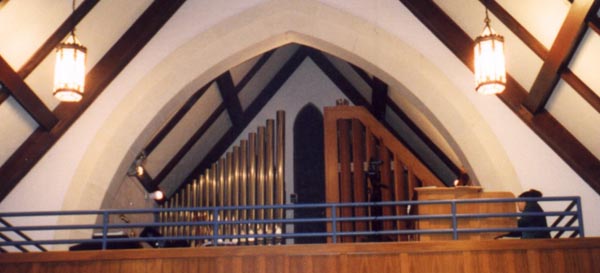 |
This is how the organ looks after installation in the balcony. The pipes to the right are enclosed with wooden slats that open as needed. The organ console is at right with electronic piano remaining at the left. |
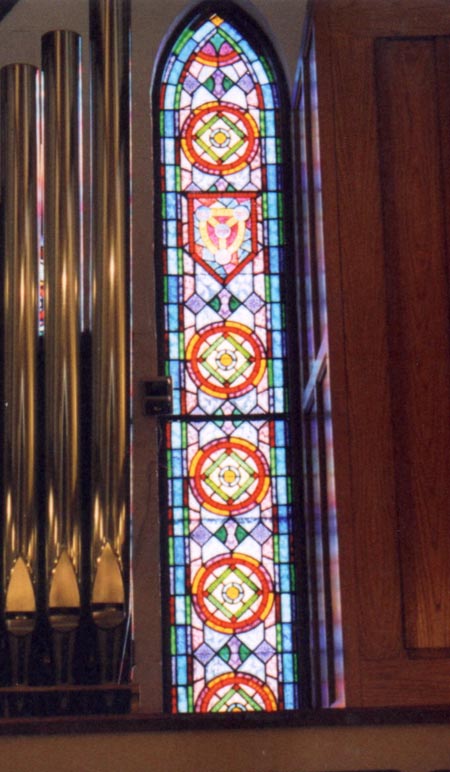 |
This is how the stained glass window in center of the organ pipes looks in daylight. At right is our current organist, Angie Pruter. As soon as the organ is free of minor problems associated with the merging of the new pipes and all the electronics connected with it, Angie plans to schedule an organ recital at which time the newly installed expanded pipe organ will be dedicated to the glory of God. | 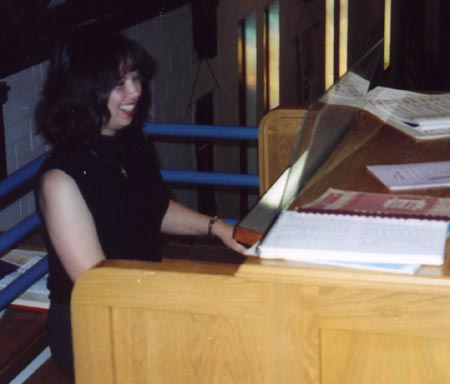 |
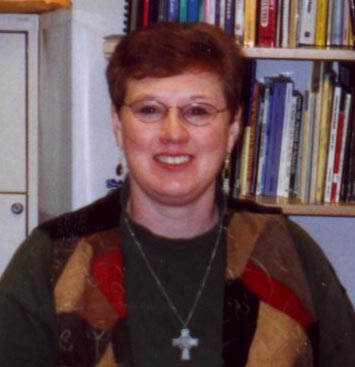 |
October 13, 2002 Installed as Director of Christian Education & Youth Deaconess Doreen Scheuerman Years at Trinity 2002 to May 7, 2006 |
The Kitchen Remodeling Project
At a special Voters Assembly meeting held Sunday, October 5, 2003, following the 11:00 church service, a ballot vote was taken that authorized the proposed kitchen remodeling project by a vote of 54 to 45. The motion authorized the church to proceed with the kitchen remodeling project using the plans, drawings, and documents developed by architect Ken Bieberly (his total fee came to $2,015), with Lancaster Construction Company as the general contractor for the project including the electrical and plumbing work for an itemized bid of $43,107, Grant Woodcraft for the cabinet work with his bid of $8,790, and Sunflower Restaurant Supply with a bid of $31,028 for the dishwasher and equipment, the electric convection oven, a 6-burner gas range with spark ignition, a 3-compartment drop-in sink, and a type 1 hood for the range, plus the fire suppression system, and that we be authorized to apply for and borrow funds from LCEF not to exceed $58,000 to finance that part of the project for which the funds have not yet been raised. Additional fees of $3,360 ended up being paid to Lancaster to comply with city requirements for a buried grease trap and $300 for an engineer's study to satisfy the city over a preliminary requirement that pipes delivering gas be replaced with larger ones. The kitchen was dedicated on Sunday, January 25, 2004. Monthly payments on the $57,300 loan from LCEF amortized over a period of 10 years will be $636.70 with the first payment due March 1, 2004. Since interest is 6% it was decided to encourage payments on principal whenever donations allow for this.
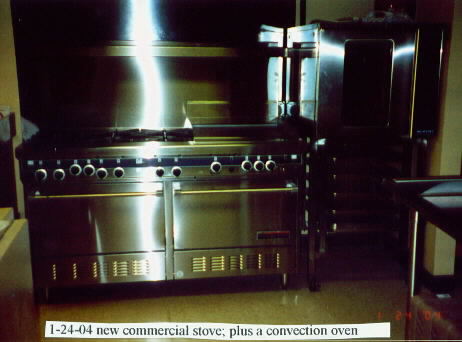 |
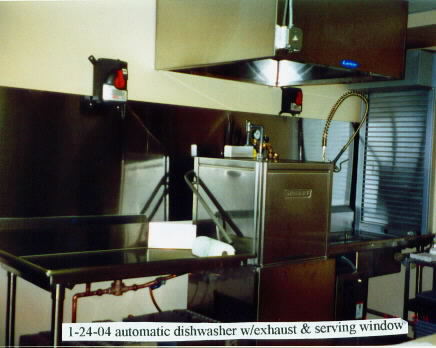 |
||
 |
| |
|
|
| |
|
Another New Kitchen Addition
Three new units (two all refrigerators and one all freezer) were added to Trinity's newly remodeled kitchen in June 2006 paid for with $600 in matching funds in July from Thrivent, plus $2,810 in memorial funds given in memory of Marie W. Haesemeyer (3-3-11 to 4-17-06) a faithful long-time member of Trinity. |
|
|
Debt Retirement
Notice of Debt Retirement from LCEF dated May 11, 2006, on the $350,000 loan dated September 29, 1997, for our Church Expansion Project was received. Agreed to apply any additional donations for this project to the Kitchen Remodeling Loan so it can be paid off as soon as possible..